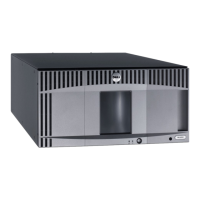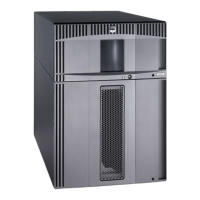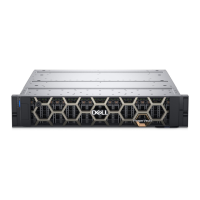Installing, Removing, and Replacing
file:///T|/htdocs/stor-sys/ML6000/en/html/ch08.htm[9/17/2012 1:50:35 PM]
Recommended Library Cabling for FC I/O Blades
Fibre optic cables connect Fibre Channel tape drives to FC I/O blades and FC I/O blades to a Storage Area Network (SAN)
fabric or host. Correctly managing these cables on the rear of the library can prevent damage to the cables and Fibre Channel
ports and ensure optimal data throughput.
Note: This section applies to libraries containing Fibre Channel tape drives, which are connected to a host or a Fibre
Channel switch using an FC I/O blade. For tape drives that are directly attached to a host or a SAN switch, follow
standard fibre optic cable handling best practices.
Ideally, an installed tape drive should be cabled to a port on the nearest FC I/O blade to eliminate the need to manage
excessively long cables. The nearest FC I/O blade is usually located in the same expansion module as the tape drive.
You will need to provide fibre cables long enough to connect a host or a SAN switch to a target port on an FC I/O blade.
It is important to consider how drives are assigned to partitions when cabling tape drives and hosts to an FC I/O blade. If you
want a host to be able to communicate with a tape drive that is assigned to a particular partition, both the drive and the host
that has access to the partition should communicate through the same FC I/O blade.
The following table provides an example of an ML6030 Control Module plus two ML600 9U Expansion Modules with FC I/O
blade-attached tape drives. The information next to the image shows each tape drive and the FC I/O blade and port to which
each tape drive is connected.
Recommended Cabling With I/O Blades in Maximum Capacity
Library
Tape
Drive I/O Blade
I/O Blade
Port
[1,1] N/A (direct
attached)
[1,2] N/A (direct
attached)
[1,3] [1,2] Port 3
[1,4] [1,2] Port 4
[0,1] [1,2] Port 5
[0,2] [1,2] Port 6
[-1,1] [-1,2] Port 3
[-1,2] [-1,2] Port 4
[-1,3] [-1,2] Port 5
[-1,4] [-1,2] Port 6
[-2,-1] [-2,-2] Port 3
[-2,-2] [-2,-2] Port 4
[-2,-3] [-2,-2] Port 5
[-2,-4] [-2,-2] Port 6

